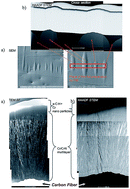Development and complex characterization of bio-tribological Cr/CrN + a-C:H (doped Cr) nano-multilayer protective coatings for carbon–fiber-composite materials
Abstract
Carbon fiber structures provide strength, stiffness, and fatigue resistance. Carbon-based materials show, however, significant oxidative degradation in air beginning at temperatures in the region of 400 °C. Therefore, a coating concept for carbon–carbon composites consists of an inner part, which serves as a structural link with stress compensation ability to the carbon substrate, and an outer part, which acts as a diffusion barrier. In the presented paper, chromium/chromium nitride (Cr/CrN) multilayer structure has been selected as the inner part. The outer part of the coating, in the presented paper, was hydrogenated amorphous carbon (a-C:H). Among doping metals, Cr, as one of the carbide formed elements, possesses an attractive combination of properties (corrosion resistance, wear resistance, etc.). Thus, in the presented paper, a-C:H part of the coating was implanted by Cr nanocrystals. Coatings were deposited by means of magnetron sputtering technique. They were subjected to complex investigations. Mechanisms of a mechanical wear of analyzed systems were presented, focusing on the cracking propagation in ball-on-disc tests using a 1 N and 5 N applied loads for 20 000 cycles. Complex microstructure analysis of presented nano-multilayer coatings, before and after mechanical tests, were performed by means of transmission electron microscopy (TEM). The microstructure characterization revealed that cracking, which was propagating in the outer part of the coating (in the carbon part) in the layer with lower nano-particle content, was stopped at the interface with the higher nano-particle content layer. In the case of the inner part of the coating (Cr/Cr2N), ceramic layers showed brittle cracking, while metallic (Cr) ones deformed plastically.


 Please wait while we load your content...
Please wait while we load your content...